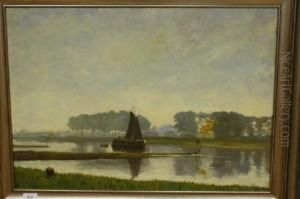Frederik Adolph Tepe Paintings
Frederik Adolph Tepe was a Dutch architect, primarily known for his work in the Neo-Gothic style, which was part of a broader European revival of medieval Gothic architecture during the 19th century. He was born in Amsterdam in 1851 and showed an early interest in architecture. Tepe was influenced by the work of P.J.H. Cuypers, another prominent Dutch architect known for his Gothic revival architecture, such as the Rijksmuseum and Amsterdam Central Station.
Tepe's education and career were rooted in the architectural traditions of the time, and he became one of the important proponents of Neo-Gothic architecture in the Netherlands. His work is characterized by the use of pointed arches, ribbed vaults, flying buttresses, and ornate detailing reminiscent of medieval Gothic cathedrals. He was particularly focused on the design and construction of Roman Catholic churches, reflecting the religious and cultural milieu within which the Gothic revival style was often situated.
During his career, Tepe designed numerous churches across the Netherlands, many of which are still standing today. These structures are not only places of worship but also serve as significant cultural heritage sites that represent the architectural history of the period. Tepe's contribution to Dutch architecture was significant in that he helped to define the visual landscape of the country during a time when there was a concerted effort to revive and celebrate historical architectural styles.
Frederik Adolph Tepe passed away in 1920, leaving behind a legacy of impressive Neo-Gothic structures. His work continues to be studied and appreciated by architects, historians, and enthusiasts of Gothic revival architecture. While he may not be as widely known as some of his contemporaries, Tepe's dedication to his craft and his impact on the architectural heritage of the Netherlands ensure that he remains an important figure in the history of Dutch architecture.

